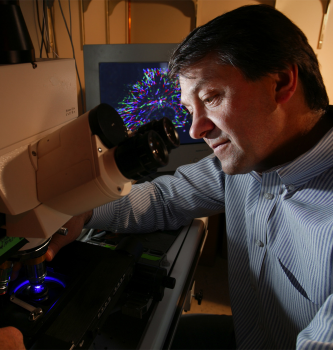 Stephen J. Doxsey |
Researchers at UMass Medical School have identified a previously unknown role in cell division for a protein already well known for its primary job of building cilia, the slender protrusions that provide motility and sensory input for organelles.
The protein, IFT88, is best known for its work in the cellular machinery that builds cilia—when IFT88 doesn’t work properly, neither do cilia. Over the last several years, scientists have linked cilia dysfunction to a number of diseases known as ciliopathies. In particular, the loss of IFT88, one of the best-studied cilia proteins, has been associated with polycystic kidney disease (PKD), which is characterized by the presence of multiple cysts in the kidneys and is believed to be caused by cilia dysfunction in kidney cells.
According to a recent paper in Nature Cell Biology, a newly discovered function for IFT88 suggests a possible alternative or contributory cause for cilia-related diseases. Stephen J. Doxsey, PhD, professor of molecular medicine and biochemistry & molecular pharmacology and cell biology and lead author of the study, shows that IFT88 also plays an important role in mitosis, a stage in cell division. Doxsey and colleagues observed that the IFT88 protein is present at the poles of the “mitotic spindle,” structures that form during mitosis and are required to guide chromosome sets as the cell divides in two. He hypothesized that the cilia protein played a transport function during mitosis that was similar to that in cilia.
“We knew that IFT88 and several other proteins in this family were present at spindle poles during mitosis but we didn’t know what function, if any, they served,” said Doxsey.
Benedicte Delaval, PhD, a postdoctoral fellow in Doxsey’s lab and first author of the Nature Cell Biology paper, added, “What we found is that IFT88 plays a part in the transport of materials required for building the spindle poles during cell division. The loss of IFT88 protein during mitosis caused a delay in mitotic division and misalignment of the direction and plane of cell division.”
This finding raises the possibility that mitotic dysfunction may play a role in previously described cilia-related disorders caused by the same family of IFT proteins. “It appears that the cellular machinery used in cilia formation is very similar to the machinery used in mitosis,” said Doxsey. “This new and distinct function for IFT88 suggests that disruption of both cilia and mitosis could co-contribute to ciliopathies.”
Since both cilia and spindles arise from a structure in the cell called the centrosome, Doxsey hypothesizes that there may be some underlying defect to the centrosome responsible for both processes going awry. “It’s possible that cilia defects alone might actually explain only part of the disease—especially in the kidney,” said Doxsey. “At this point, we don’t know. What we do know is that IFT88’s role in mitosis has yet to be fully explored. It appears, though, to play a similar role in two different functions. We need to take a more global look at the cell to determine what precisely is going on in this family of disorders.”